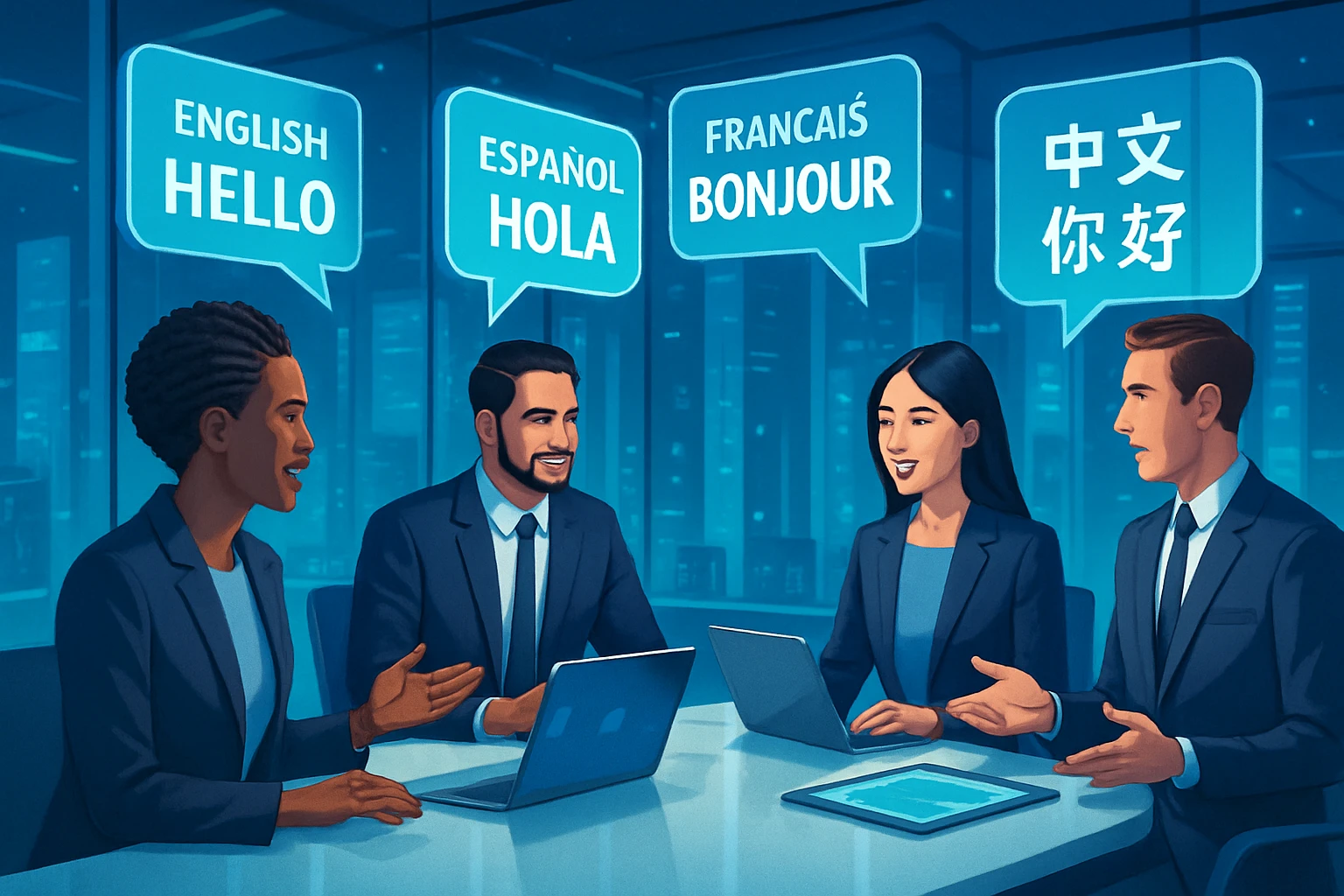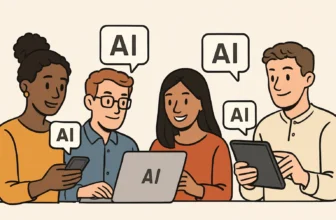
How AI Translation is Revolutionizing Commerce
Did you know that over 75% of consumers are more likely to buy from a brand if the product info is in their native language? Yep, even the savviest marketing campaign can fall flat if the message gets lost in translation. And for anyone running a global business—or even just planning to expand abroad—that stat should stop you in your tracks.
Here’s the thing: most of us have felt that frustration when trying to decipher a menu overseas or muddling through a foreign website, right? Now imagine running a business and having your product, your brand, and your offers get misinterpreted—or worse, completely ignored—because they weren’t accessible linguistically. That’s the communication gap AI translation is swooping in to fix.
Why AI Translation Matters More Than Ever
We’re in a weird but exciting space right now. Businesses are scaling internationally faster than ever, thanks to e-commerce, remote work, and global logistics. But while tech has taken us to new markets, language has remained this awkward speed bump. And traditional solutions like hiring human translators for every little piece of content? Beautifully accurate, sure—but painfully slow and very expensive.
That’s exactly where AI translation steps in to save the day. With advanced neural networks and machine learning, AI translation tools like DeepL, Google Translate (yes, it’s seriously leveled up), and even real-time voice translators are making it possible to:
- Instantly translate marketing content in dozens of languages—without hiring a massive team.
- Communicate with international partners and clients in real-time, overcoming misunderstandings and building trust faster.
- Localize product offerings based on language and culture, not just word-for-word translations.
I worked with a small eco-friendly skincare brand that wanted to enter the Spanish market. They used AI translation to localize their website copy in just a few days. Not only did their conversion rate spike by 24%, but customer reviews raved about how “authentic” the messaging felt. And they didn’t need to hire a multilingual team overnight—just smart tools.
How You Can Jump In
Curious how to get started with AI translation for your own business or travel plans? Here are a few quick wins:
- Start small – Use AI translation to test content in a new market. Website banners, social media posts, or customer service emails are great starting points.
- Pair human and machine – Let AI do the heavy lifting, then have a native speaker give it a final polish. Best of both worlds.
- Explore real-time tools – Traveling or dealing with meetings in multiple time zones? Apps like iTranslate or Pocketalk are lifesavers for voice and on-the-fly translations.
We’re not just talking about better communication—we’re talking about access. Connection. Opportunity. This isn’t some sci-fi future anymore. AI translation is here, reshaping how we connect across borders and cultures.
So whether you’re a digital nomad, a startup founder, or just dreaming of selling your handmade ceramics in Tokyo—AI’s got your back. The world’s never been closer.
Breaking Down Language Barriers
Did you know that over 7,000 languages are spoken around the world—yet most global businesses operate in just 10? Wild, right? That massive language gap has been a major roadblock for companies trying to go global… until now.
Let’s face it—handling language differences in business can feel like herding cats wearing noise-canceling headphones. Whether you’re trying to close a deal in Tokyo, market your app in São Paulo, or onboard a new partner in Berlin, things get tricky when you’re not speaking the same language—literally.
I’ve been there. A few years ago, I helped a small startup expand into several European countries. We were excited, but we quickly hit a wall: translating contracts, customer emails, marketing copy—it was expensive and sloooow. Plus, let’s be honest, Google Translate wasn’t cutting it back then. But today? Things have changed. Big time.
How AI Translation Is Changing the Game
AI translation tools like DeepL, Google Cloud Translation, and Microsoft’s Azure Translator are not only speeding up the process—they’re making it smarter. These tools don’t just swap words; many use machine learning to understand context, slang, grammar quirks, and even tone (because yes, there’s a difference between “Please respond” and “Hey, hit me back!”).
Here’s what you can start doing today to break down those language barriers in your business:
- Start Small with Smart Tools: Sign up for tools like DeepL or Google Translate API and integrate them into your customer service, emails, or even your website. These tools are getting scary-good at sounding human.
- Use Real-Time Translation in Conversations: Tools like Zoom with real-time captions or Microsoft Teams Translate can instantly translate live conversations. Perfect for global meetings or quick chats with international clients.
- Don’t Ditch the Human Touch: For legal docs or critical brand messaging? Pair AI with a professional translator to fine-tune your message. This hybrid approach saves time while keeping things accurate and culturally nuanced.
Real-World Win: A Coffee Shop Goes Global
One of my favorite examples? A small café chain based in Paris started using AI translation to launch its online store in multiple languages. They went from French-only to operating in five languages in under two months—and saw a 30% increase in overseas orders. Not bad for a project led by two people and a laptop, right?
The Bottom Line
Language doesn’t have to be a wall anymore—it can be a bridge. AI-powered translation has come a long way, and it’s now within reach for travelers, solopreneurs, and global giants alike. You don’t have to know seven languages to do business in seven countries—you just need the right tools.
Ready to go global without flipping through phrasebooks? Start experimenting with AI translation today—and watch your world get a whole lot bigger.
Streamlining International Communication
Did you know that language barriers cost the global economy an estimated $134 billion every year in lost productivity and stalled negotiations? Crazy, right? It makes you wonder how many amazing deals and connections are slipping through the cracks simply because we can’t understand each other well enough.
If you’ve ever tried to close a deal with a company overseas, you’ll know the struggle is *very* real. All it takes is one misinterpreted phrase in an email or a poorly-translated product description, and boom — you’re deep in awkward territory. I once sat through a Zoom call where “test run” got translated to “dangerous experiment”… let’s just say it didn’t exactly instill confidence.
The good news? We don’t have to live like it’s 1999 anymore. AI-powered translation tools have seriously stepped up their game, turning messy, clunky communication into smoother, more productive conversations. Whether you’re managing a global team, selling to foreign customers, or chatting with support reps in a different time zone — these tools can be absolute lifesavers.
How to Use AI Translation to Level Up Your Global Communication
- Real-time Translation for Live Calls: Tools like Zoom’s real-time transcription or Microsoft Teams with AI captioning can translate meetings on the fly. No more awkward silences while someone runs to Google Translate.
- AI-Powered Chat and Email Assistants: Platforms like DeepL and Google Translate have gotten scarily accurate — and now integrate with your favorite messaging apps. Just type in your language, and they translate into your client’s.
- Website Localization on Autopilot: Tools like Weglot and Lokalise make translating your whole website as easy as pushing a button. You don’t need to hire a team of translators anymore (though… human touch still helps for nuance!).
Personally, switching to AI translation for my remote clients saved me hours of back-and-forth. I started using DeepL to draft contracts and email proposals for a German company I work with, and their response? “We thought a local wrote this!” That kind of feedback feels like magic.
Where We’re Headed (And Why It’s Exciting)
AI translation isn’t just fixing broken conversations. It’s opening doors. Imagine jumping into new markets without fear that your message will get lost — or misunderstood. Imagine connecting authentically with customers in Tokyo, Madrid, or São Paulo — without hiring a full-time interpreter.
So if you’ve been holding back on going global because you’re worried about “not speaking the language,” take this as your gentle push: the tools are ready — and they’re ridiculously powerful.
Start small. Translate an email. Try captioning your next webinar. Play around with a website plugin. And watch how quickly “We’re limited by language” turns into “We’re global now.” 🌍
Cultural Nuances: Beyond Word-for-Word Translation
Did you know that 75% of consumers prefer to buy products in their native language—even if the quality isn’t perfect? Now, imagine if that translated message actually *felt* native, jokes and all. That’s where cultural nuance steps in—and where AI is starting to seriously shine.
Let’s be real: translating isn’t just about swapping out words. If it were, Google Translate would be ruling the world by now, right? But here’s the thing—words carry tone, emotion, history. What makes someone laugh in Japan might fall flat in Spain. Or worse, be downright offensive in Germany. Yikes.
I once worked with a friend launching a skincare brand into the Chinese market. Their tagline? “Get glowing fast.” Seems innocent enough… until we found out that in certain regions, it sounded like slang for rushing into something without thinking. Not exactly the vibe for a self-care brand.
Why Nuance Matters in Translation
Whether you’re pitching a product in France or navigating a deal in Brazil, word-for-word translation won’t cut it. Cultures value different things—formality, humor, metaphors, even silence. And missing those subtle cues can tank a campaign or derail a sales call before it even starts.
That’s why AI-powered translation tools are stepping up. They’re not just parroting your words; they’re learning context. Want examples? Buckle up:
- Netflix: Its AI-enhanced subtitling adapts jokes, idioms, and pop culture references for local audiences. A sarcastic quip in English might become a witty pun in Korean. Pure genius—and it keeps viewers hooked.
- Airbnb: Their AI translation layers are helping property listings feel more “local” to users browsing in different regions. Descriptions aren’t just accurate—they sound like a host from that area actually wrote them.
- Facebook Ads: The platform’s auto-translate features are beginning to adjust tone based on country—more formal in Germany, more playful in the U.S.—boosting engagement big time.
How Can *You* Leverage This?
- Choose Smart AI Tools: Use platforms trained on real human behavior—like DeepL or Lokalise—that go beyond literal translation and account for tone and cultural quirks.
- Test with Locals: Before launching globally, send your translated copy to someone who *actually lives* in the target culture. You’ll be amazed what they catch.
- Train Custom Models: Larger businesses? You can train AI with your brand’s voice and popular regional phrases to keep messaging consistent *and* culturally on-point.
Let AI Speak Their Language—Truly
So here’s the good news: cultural nuance doesn’t have to be a hurdle anymore. With smart translation tech and a sprinkle of curiosity, you can speak to people in ways that actually resonate. It’s not just about being understood. It’s about making people feel seen, heard—and yes, culturally comfortable.🌎
And when you do that? That’s when global business gets personal. In the best possible way.
Future Trends: What’s Next in AI Language Translation
Did you know that by 2025, over 75% of customer interactions are expected to be managed without a human? Yep, thanks to AI – and a huge part of that is happening through smarter language translation. We’re not just talking about fixing bad subtitles on foreign films or fumbling through Google Translate anymore. We’re talking real-time, lightning-fast, near-perfect communication across cultures, borders, and time zones.
From Jet Lag to Jet Set: Why This Matters
Okay, if you’ve ever tried to close a deal while mentally translating your client’s request mid-meeting – or asked for “no meat” at a restaurant and somehow ended up with extra sausage – you already get why this matters. Language barriers, even tiny ones, create friction. Lost time, missed opportunities, confused customers… sound familiar?
For global businesses and adventure-hungry travelers alike, the future of AI translation isn’t just about convenience. It’s about staying relevant and competitive. And honestly? The pace of change is wild.
So, What Should We Expect?
Here’s where things get exciting. Let’s break down a few jaw-dropping trends headed our way:
- Real-Time Voice Translation 2.0: Think of Zoom calls where each participant speaks their native language, and the system auto-translates it in real time, with natural tone and emotion. We’re almost there — companies like Meta and Google are racing to perfect this.
- Contextual AI: Future AI translators won’t just substitute words — they’ll understand situational context. So your Spanish AI won’t confuse “client” with “customer” during a legal briefing. Fewer mix-ups, more professionalism.
- Multimodal Translation: Photos, voice, video, documents — all instantly translated. Imagine snapping a dinner menu or reviewing a French RFP and fully understanding it with cultural nuance. Epic, right?
What Can You Do Now to Get Ahead?
Don’t wait for the future to show up on your doorstep. Prep now, and you’ll be ahead of the curve — not scrambling to catch up. Here’s how:
- Invest in scalable, AI-powered translation tools: If your website, app, or product isn’t already optimized for multilingual audiences, start there. Tools like DeepL, Lokalise, and Amazon Translate are totally worth exploring.
- Train your team to use these tools: It’s not just about having the tech — make sure your customer support, marketing, and sales teams can use translation tools fluently (no pun intended). A short training now can save huge headaches later.
- Test in new markets using AI: Use AI translation to test-launch products in markets you’ve never dared enter before. The cost of entry has never been lower — and the payoff? Huge.
Bottom Line: The Future Talks, and It’s Multilingual
I’ve worked with brands that used to limit their reach because “the language barrier is too tough.” But once they tapped into AI translation, suddenly they’re getting traction in Tokyo, Dubai, and São Paulo. It’s a game-changer — and honestly, it levels the playing field for small businesses, creatives, and travelers alike.
The future is here. It speaks every language. And with the right mindset and tools, so can you. 🌍
Embrace the Future of Communication
Did you know that around 76% of online shoppers prefer to buy products in their native language? Think about that for a second. That’s over three-quarters of your potential global audience who might bounce away just because they can’t understand what you’re offering. Oof, right?
Here’s the thing—and I hear this from small business owners and world travelers alike all the time—language shouldn’t be the barrier that blocks all the amazing opportunities waiting beyond your doorstep (or domain). But traditionally, expanding globally meant back-and-forths with pricey human translators or clunky tools that made you sound like a badly dubbed movie.
I totally get it. I once tried pitching a service to a client in Japan using only translated brochures and… let’s just say I accidentally offered them “a cheese cloud of solutions.” Umm, yeah. Not exactly a confidence booster.
So, how do we fix this?
Enter AI translation—your new secret weapon for going global without getting lost in translation. Now, before you picture cold robots speaking monotone French, let me stop you. Today’s AI is smarter, friendlier, and way more accurate than you’d expect. We’re talking about natural, culturally aware translations that actually feel human.
Here are a few simple but powerful ways to start embracing AI translation in your business or travels:
- Use AI-powered translation platforms: Tools like DeepL, Google Translate (yes, it’s gotten better!), and Microsoft Translator now offer AI-enhanced options that adapt tone and context. Start by translating your product descriptions, social media posts, or travel content.
- Integrate multilingual chatbots: Imagine offering real-time customer support in Spanish, Mandarin, or Italian—even if you only speak English. AI makes it seamless and scalable.
- Translate on the go: Traveling? Download translation apps that use AI to interpret signs, menus, even voice chats. I once ordered dinner flawlessly in a Paris café using just my phone. Felt like a tech-savvy James Bond.
Looking ahead…
Here’s what I want you to remember: language access is power. It’s the power to sell, to connect, to grow. AI translation isn’t some futuristic fantasy—it’s happening now. And businesses that embrace it early? They’re already speaking the language of success (literally).
So, are you ready to stop letting language be a roadblock and start using it as your launchpad? Whether you’re a global brand or a solo traveler chasing experiences, AI translation is here to open doors for all of us.
The future of communication is fluent, fast, and finally—fair. Let’s dive in together.












